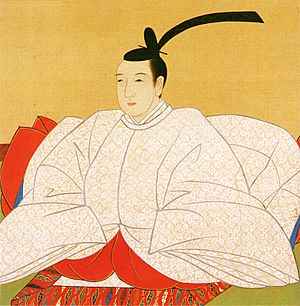Emperor Ninkō facts for kids
Quick facts for kids Emperor Ninkō仁孝天皇 |
|
|---|---|

Ninkō
|
|
| Emperor of Japan | |
| Reign | 7 May 1817 – 21 February 1846 |
| Enthronement | 31 October 1817 |
| Predecessor | Kōkaku |
| Successor | Kōmei |
| Shōgun |
See list
Tokugawa Ienari
Tokugawa Ieyoshi |
| Born | Ayahito (恵仁) 16 March 1800 |
| Died | 21 February 1846 (aged 45) |
| Burial | Tsuki no wa no misasagi (後月輪陵), Kyoto |
| Spouse | |
| Issue |
|
| House | Imperial House of Japan |
| Father | Emperor Kōkaku |
| Mother | Kajyūji Tadako |
| Religion | Shinto |
| Signature |  |
Emperor Ninkō (仁孝天皇, Ninkō-tennō, 16 March 1800 – 21 February 1846) was the 120th Emperor of Japan. He ruled from 1817 until he passed away in 1846. During his time, the power of the ruling Shōgun (military leader) started to weaken even more.
Japan faced many problems during his reign. There were natural disasters like famines, especially the Tenpō famine. There was also a lot of corruption in the government. Plus, Western countries started to get more involved in Japan. These issues made people lose trust in the bakufu (the Shōgun's government). Emperor Ninkō tried to bring back old court traditions and ceremonies, as his father wished. It's not clear how much the Emperor was involved in the political problems of his time.
Emperor Ninkō had fifteen children with different mothers, but only three of them lived to be adults. His fourth son, Prince Osahito, became the next emperor, Emperor Kōmei, after Ninkō's death in 1846. Even though the Shōgun still held most of the power, Ninkō's reign marked the beginning of the Bakumatsu period, which was the end of military rule in Japan.
Contents
Emperor Ninkō: His Life and Reign
Early Life and Becoming Emperor
Emperor Ninkō was born on March 16, 1800. His personal name was Ayahito (恵仁). He was the fourth son of Emperor Kōkaku. Out of sixteen children, he was the only one who lived to adulthood.
In 1809, Prince Ayahito was named crown prince. He was adopted by his father's main wife, Imperial Princess Yoshiko (欣子内親王). His birth mother was one of his father's concubines, Kajyūji Tadako (勧修寺婧子). Prince Ayahito and his family lived in the Dairi (Inner Palace) of the Heian Palace in Kyoto.
His Time as Emperor
Prince Ayahito became Emperor on October 31, 1817. This happened after his father, the Retired Emperor, stepped down from the throne. Emperor Ninkō followed his father's wishes and tried to bring back old court ceremonies and traditions. For example, he worked to restore the title tennō, which is the official title for the Emperor.
One of Ninkō's important actions was setting up the Gakushūsho. This was a school for the court nobles, located just outside the Imperial Palace. It was the early version of the famous Gakushūin school.
Challenges During His Reign
A major event during Emperor Ninkō's rule was the Tenpō famine. This terrible famine lasted from 1833 to 1837. It was worst in northern Honshū and was caused by floods and very cold weather.
Ninkō's reign also saw the power of the Shōgun start to decline. The Tenpō famine and other natural disasters hit Japan hard. These events made people lose faith in the ruling Shōgun's government.
In 1837, a man named Ōshio Heihachirō led a revolt in Osaka. He was protesting against corrupt officials who refused to help feed the poor people in the city. In the same year, an American merchant ship was driven away by coastal cannons. This was known as the Morrison Incident.
Even though order was eventually restored, common people felt a lot of anger towards the government. It's not clear what role, if any, the Emperor played during these times of trouble.
Death and Burial
Emperor Ninkō passed away on February 21, 1846. He was buried in the Imperial mausoleum, Nochi no Tsukinowa no Higashiyama no misasagi (後月輪東山陵). This burial site is located at Sennyū-ji in Higashiyama-ku, Kyoto. Many other emperors are also buried there, including his father, Emperor Kōkaku, and his son, Emperor Kōmei.
Eras During Ninkō's Reign
In Japan, the years of an emperor's reign are often identified by special era names, called nengō.
The following era names were used during Emperor Ninkō's reign:
Emperor Ninkō's Family
Emperor Ninkō had 7 sons and 8 daughters with different mothers. However, only three of his children lived past childhood:
- Imperial Prince Osahito (who became Emperor Kōmei)
- Imperial Princess Katsura-no-Miya Sumiko
- Imperial Princess Kazu-no-miya Chikako
Spouses and Concubines
Emperors in Japan often had multiple spouses and concubines. Here are some of the important women in Emperor Ninkō's life:
- Kōgō (Empress): Takatsukasa Tsunako (鷹司繋子) (later Shinkokamon'in)
- Nyōgo (Consort): Takatsukasa Yasuko (鷹司祺子) (later Shinsakuheimon'in)
- Concubine: Ogimachi Tsuneko (正親町雅子) (later Shintaikemon'in), who was the mother of Emperor Kōmei.
- Concubine: Kanroji Kiyoko (甘露寺妍子), mother of Princess Sumiko.
- Concubine: Hashimoto Tsuneko (橋本経子) (later Kangyou'in), mother of Princess Kazu.
See also
 In Spanish: Ninkō Tennō para niños
In Spanish: Ninkō Tennō para niños

